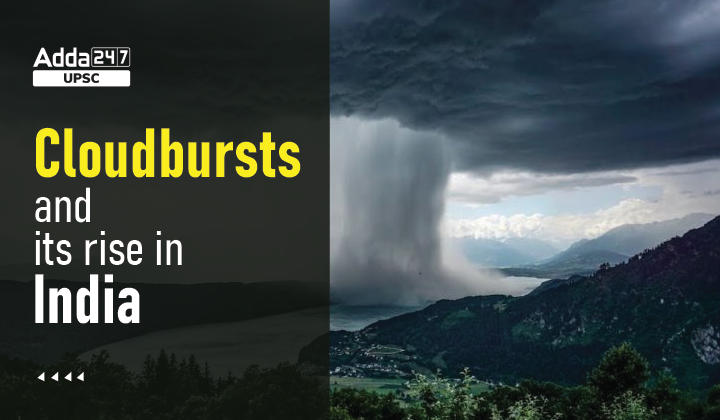Table of Contents
Cloudbursts and its rise in India- Relevance for UPSC
General Studies I- Climatic Changes.
In News
Over 20 people have been killed in destruction caused by cloudbursts and flash floods in different parts of Himachal Pradesh and Uttarakhand over the last three days.
Isolated areas in these two states have reported heavy rainfall during this time, triggering landslides and flash floods that have disrupted rail and road traffic, and resulted in house and wall collapses.
What are Cloudbursts?
- A cloudburst is a localized but intense rainfall activity.
- Short spells of very heavy rainfall over a small geographical area can cause widespread destruction, especially in hilly regions where this phenomenon is the most common.
- Not all instances of very heavy rainfall, however, are cloudbursts.
- A cloudburst has a very specific definition: Rainfall of 10 cm or more in an hour over a roughly 10 km x 10-km area is classified as a cloudburst event.
- By this definition, 5 cm of rainfall in a half-hour period over the same area would also be categorized as a cloudburst.
How is it different from normal rainfall?
- To put this in perspective, in a normal year, India, as a whole, receives about 116 cm of rainfall over the entire year.
- This means if the entire rainfall everywhere in India during a year was spread evenly over its area, the total accumulated water would be 116 cm high.
- Though there are regional variations yet, any place in India can be expected to receive about 116 cm of rain in a year.
- During a cloudburst event, a place receives about 10% of this annual rainfall within an hour.
How common are cloudbursts?
- Cloudbursts are not uncommon events, particularly during the monsoon months.
- Most of these happen in the Himalayan states where the local topology, wind systems, and temperature gradients between the lower and upper atmosphere facilitate the occurrence of such events though not every event that is described as a cloudburst is actually, by definition, a cloudburst as these events are highly localized.
- They take place in very small areas which are often devoid of rainfall measuring instruments.
- The consequences of these events, however, are not confined to the small areas.
- The heavy rainfall events often trigger landslides and flash floods, causing extensive destruction downstream because of the nature of terrain and as a result of this, every sudden downpour that leads to destruction of life and property in the hilly areas gets described as a “cloudburst”, irrespective of whether the amount of rainfall meets the defining criteria.
- At the same time, it is also possible that actual cloudburst events in remote locations are not recorded.
Can cloudbursts be forecast?
- The India Meteorological Department forecasts rainfall events well in advance, but it does not predict the quantum of rainfall — in fact, no meteorological agency does.
- The forecasts can be about light, heavy, or very heavy rainfall, but weather scientists do not have the capability to predict exactly how much rain is likely to fall at any given place.
- Additionally, the forecasts are for a relatively large geographical area, usually a region, a state, a meteorological sub-division, or at best a district.
- As they zoom in over smaller areas, the forecasts get more and more uncertain.
- Theoretically, it is not impossible to forecast rainfall over a very small area as well, but it requires a very dense network of weather instruments, and computing capabilities that seem unfeasible with current technologies.
- As a result, specific cloudburst events cannot be forecast.
- No forecast ever mentions a possibility of a cloudburst instead there are warnings for heavy to very heavy rainfall events, and these are routinely forecast four to five days in advance.
- Possibility of extremely heavy rainfall, which could result in cloudburst kind of situations, are forecast six to 12 hours in advance.
Increasing Incidents
- There is no long-term trend that suggests that cloudbursts, as defined by the IMD, are rising however, the incidents of extreme rainfall, as also other extreme weather events, are increasing — not just in India but across the world.
- While the overall amount of rainfall in India has not changed substantially, an increasing proportion of rainfall is happening in a short span of time which means that the wet spells are very wet, and are interspersed with prolonged dry spells even in the rainy season.
- This kind of pattern, attributed to climate change, does suggest that cloudburst events might also be on the rise.




 TSPSC Group 1 Question Paper 2024, Downl...
TSPSC Group 1 Question Paper 2024, Downl...
 TSPSC Group 1 Answer key 2024 Out, Downl...
TSPSC Group 1 Answer key 2024 Out, Downl...
 UPSC Prelims 2024 Question Paper, Downlo...
UPSC Prelims 2024 Question Paper, Downlo...
